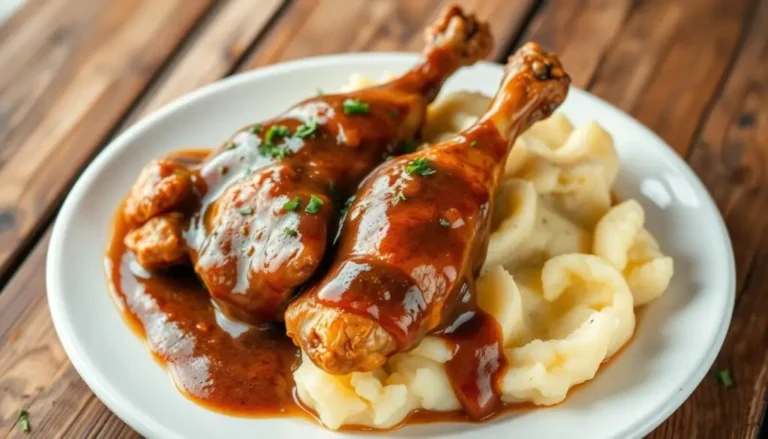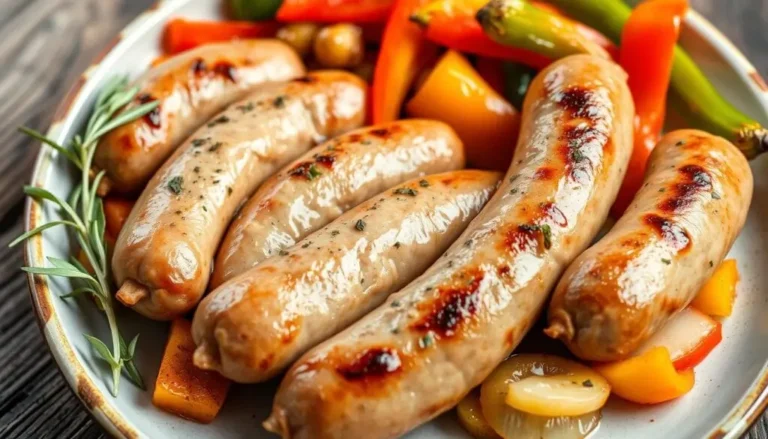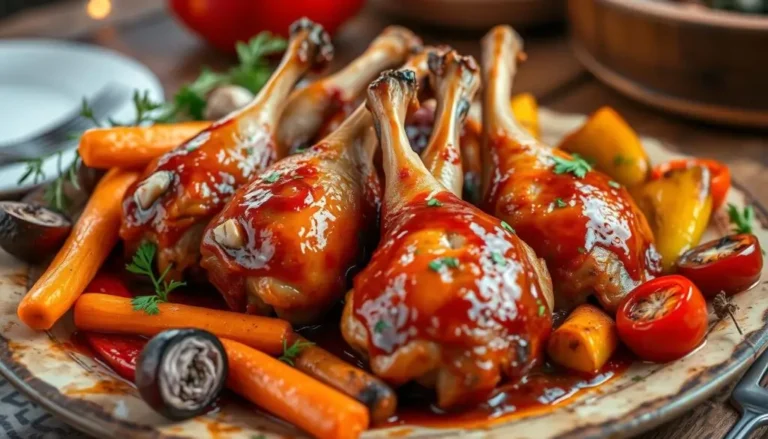Best Turkey Brine Recipe – Juicy, Flavorful & Easy to Make
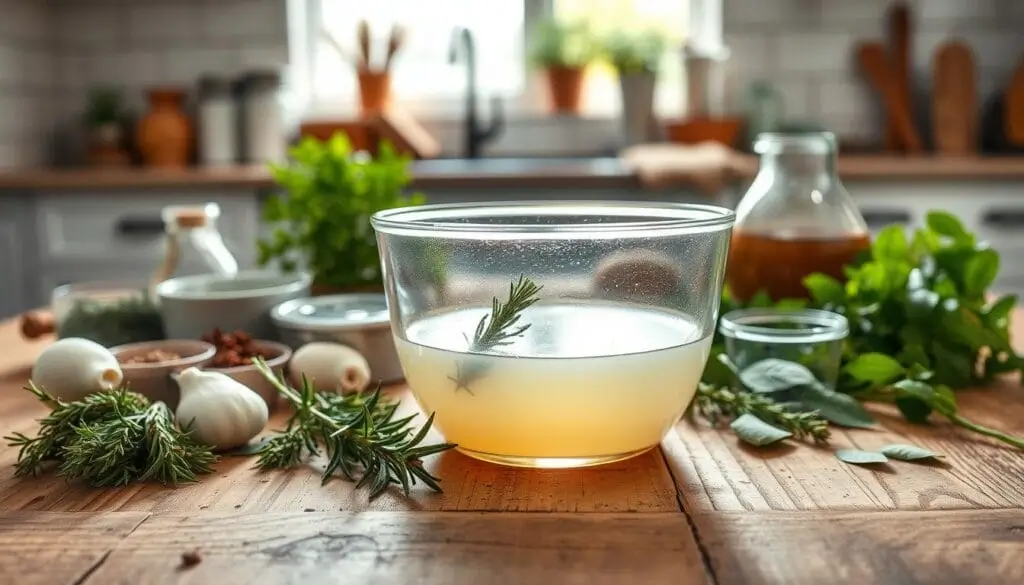
Table of Contents
I remember my first Thanksgiving dinner vividly. My family’s turkey brine recipe was the star. It combined the best of both worlds: a moist turkey and rich flavors. The recipe is quick, taking only 15 minutes to prepare and cook for 10 people.
The secret to a juicy turkey is the brine. It’s a mix of water, kosher salt, and other ingredients. This makes the turkey both moist and full of flavor.
Using a turkey brine can take your holiday meal to the next level. The best part? It’s simple to make. You just need water, kosher salt, and brown sugar. This easy recipe ensures a delicious, juicy turkey that will wow your guests.
Key Takeaways
- A good turkey brine recipe can make a significant difference in the flavor and moisture of the turkey.
- The best turkey brine recipe involves soaking the turkey in a mixture of water, kosher salt, and other ingredients.
- A thanksgiving turkey brine can be used to add flavor to your holiday meal.
- The prep time for a turkey brine recipe is relatively short, at just 15 minutes.
- The total time required for a turkey brine recipe is also 15 minutes, making it a quick and easy option.
- A turkey brine recipe can serve up to 10 people, making it perfect for large gatherings.
Understanding Turkey Brining: The Science Behind the Magic
Brining is a key technique for a juicy turkey. It involves soaking the turkey in a mix of water, salt, and sometimes sugar and other flavorings. This helps break down proteins and adds moisture to the meat. A homemade turkey brine usually includes salt, water, and sugar.
A simple brine can be made with 1 cup of kosher salt and 1 gallon of water. This solution tenderizes the meat. The science behind brining is osmosis. The salt in the brine draws out moisture from the meat, then replaces it with flavorful solution. This makes the turkey tender and juicy, with enhanced flavor.
There are two brining methods: wet and dry. Wet brining involves soaking the turkey in a saltwater solution. Dry brining uses a salt and seasoning rub. Both methods can make delicious turkey. Wet brining is often chosen for its moisture-adding benefits. With a homemade brine and a few steps, you can make a juicy turkey that wows your guests.
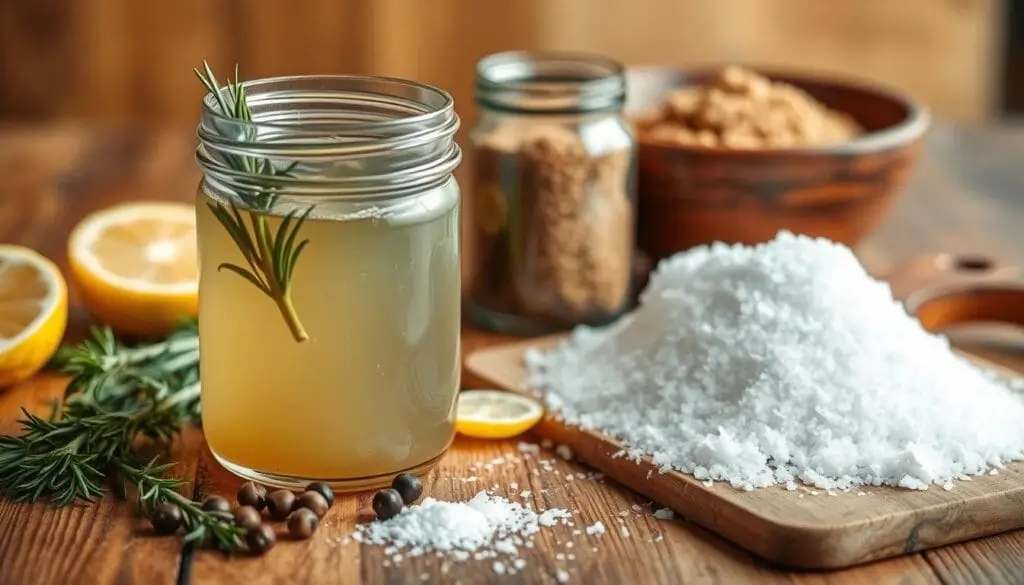
- Increased moisture and tenderness
- Enhanced flavor
- Reduced risk of overcooking
Understanding brining and using a simple brine can elevate your turkey. It makes for an unforgettable meal.
Essential Equipment for Perfect Turkey Brining
To make a great turkey brine, you need the right tools. When you learn to brine a turkey, you’ll need a few important items. A big, food-safe container is key. It should be big enough for the turkey and the brine. A 5-gallon bucket or a 12-quart stockpot works well.
Here are some other must-haves:
- A brining bag (optional but recommended for convenience and to prevent contamination)
- Kosher salt (Morton’s or Diamond Crystal work well, but note that Diamond Crystal requires a slightly larger amount due to its coarser crystals)
- A refrigerator with a temperature control to keep the turkey at a safe temperature below 40°F
- A meat thermometer to ensure the turkey is cooked to a safe internal temperature
Using the right tools makes brining a turkey easier. It helps you get a moist and tasty turkey. Always keep food safety in mind when handling and storing your turkey.
| Equipment | Description |
|---|---|
| Food-grade container | Large enough to hold the turkey and brine solution |
| Brining bag | Optional, for convenience and to prevent contamination |
| Kosher salt | Morton’s or Diamond Crystal, for the brine solution |
| Refrigerator | With temperature control, to keep the turkey at a safe temperature |
| Meat thermometer | To ensure the turkey is cooked to a safe internal temperature |
The Best Turkey Brine Recipe for a Show-Stopping Bird
To make the best turkey brine, you need a few key ingredients. Start with 1 gallon of water. Then add 1 cup of kosher salt and 1 cup of packed brown sugar. These ingredients are the base of the brine.
For extra flavor, you can add garlic, orange, and lemon slices. Also, include dried rosemary, sage, thyme, black peppercorns, and bay leaves. These will give your turkey a rich, savory taste that will wow your guests.
Base Brine Ingredients
- 1 gallon water
- 1 cup kosher salt
- 1 cup packed brown sugar
- 5 cloves garlic
- 1 orange and 1 lemon (thinly sliced)
Optional Flavor Enhancers
- 1 tablespoon dried rosemary
- 1 tablespoon ground sage
- 1 tablespoon dried thyme
- 1 tablespoon black peppercorns
- 3 bay leaves
By using this homemade turkey brine recipe, you’ll get a moist and delicious turkey. It’s easy to make and requires just a few ingredients. This makes it perfect for anyone trying brining a turkey for the first time.
The brining time depends on the turkey’s size. Smaller turkeys (10 to 14 pounds) need 12 hours. Medium-sized turkeys (14 to 18 pounds) require 16 to 18 hours. Larger turkeys (over 18 pounds) might need up to 24 hours to soak up all the flavors.
| Turkey Size | Brining Duration |
|---|---|
| 10-14 pounds | 12 hours |
| 14-18 pounds | 16-18 hours |
| over 18 pounds | 24 hours |
Preparing Your Turkey for Brining
To start, use a fresh or thawed turkey for brining. Don’t use a frozen turkey that’s already been brined or injected with sodium. Choose a turkey that fits in your brine container and meets your needs.
Thaw your turkey as the package says. It usually takes 24 hours for every 4-5 pounds. After thawing, take out the giblets and rinse the turkey with cold water.
For a simple turkey brine, mix kosher salt, sugar, and water. Use 1/2 cup of kosher salt for every 2 gallons of water. You can add lemons or garlic for extra flavor.
Here’s a quick guide to get you started:
- Thaw the turkey as directed
- Remove giblets and neck
- Rinse the turkey with cold water
- Mix the brine ingredients
- Soak the turkey in the brine
By following these steps and using the right ingredients, you’ll make a juicy and tasty turkey.
| Brine Ingredient | Quantity |
|---|---|
| Kosher Salt | 1/2 cup |
| Sugar | 1 cup |
| Water | 2 gallons |
Step-by-Step Brining Process
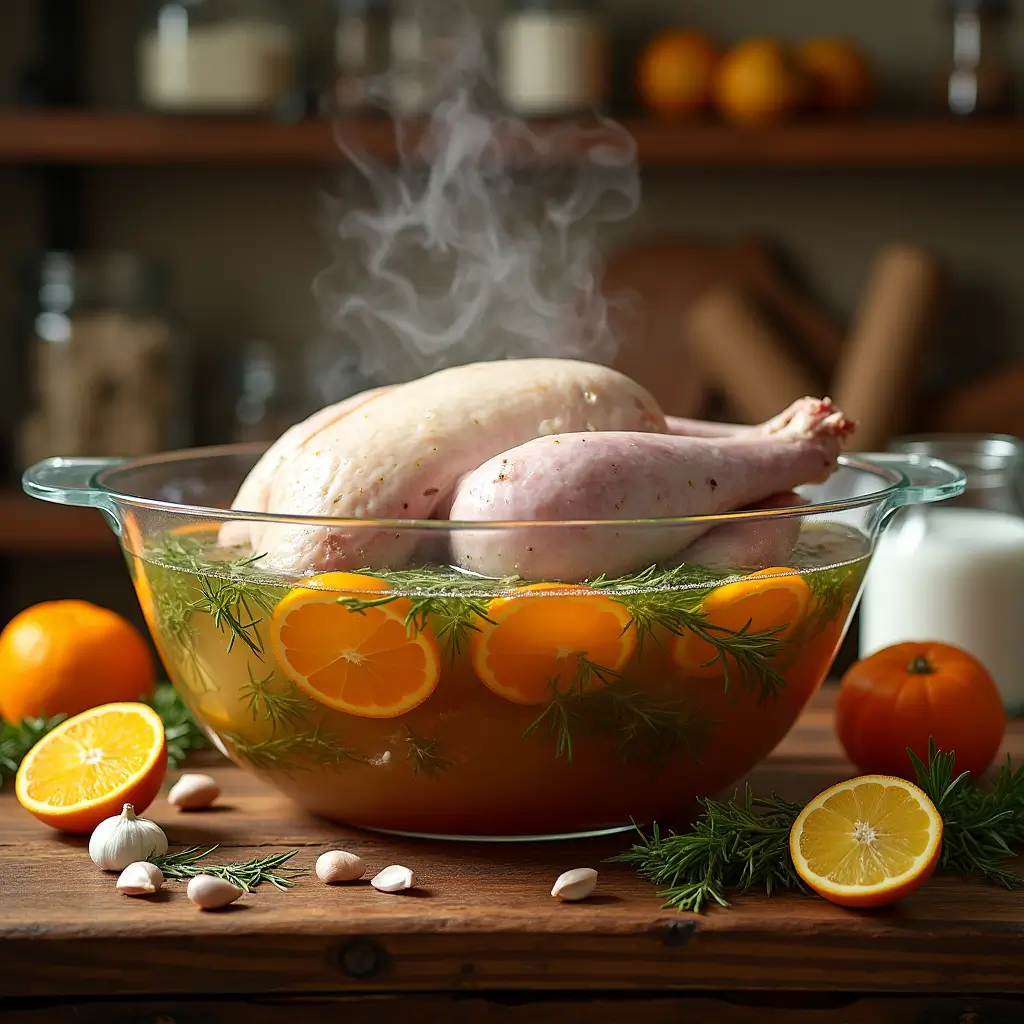
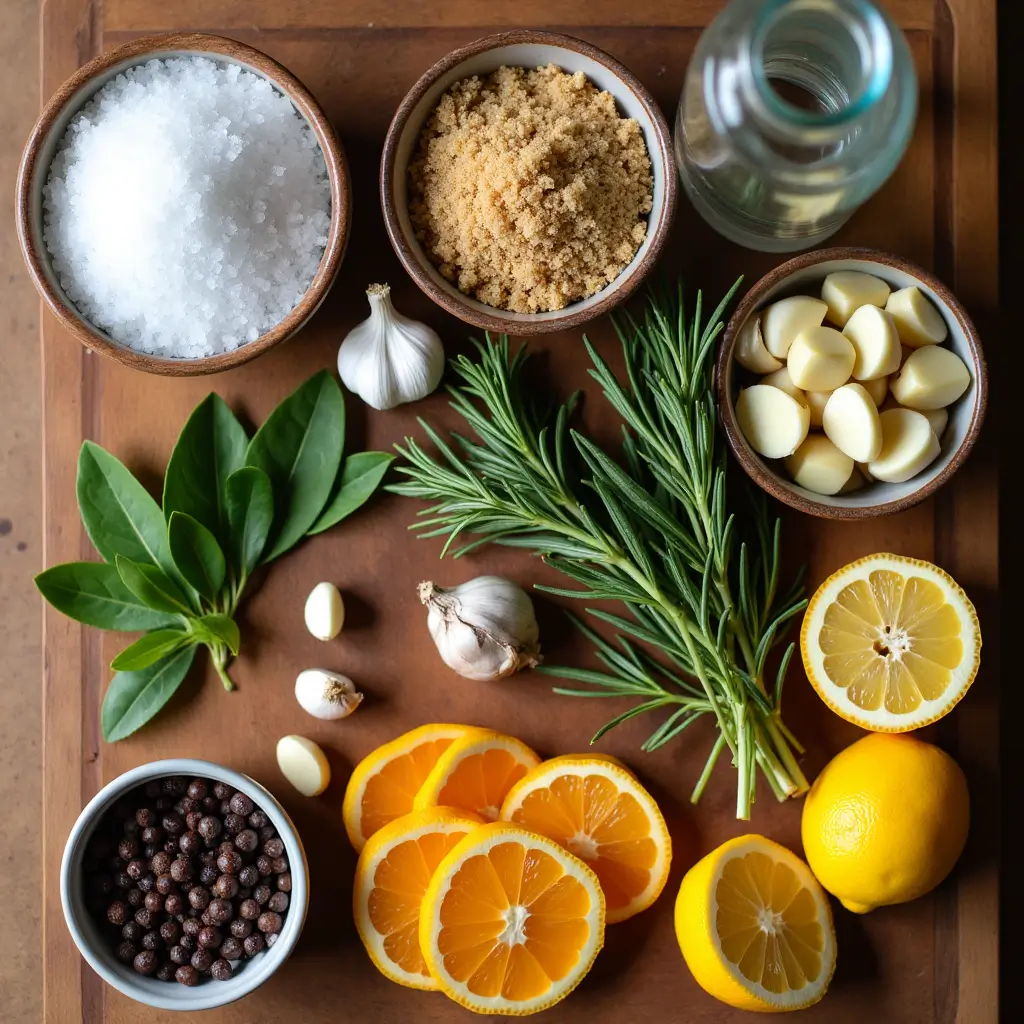
To get a perfectly brined turkey, follow a step-by-step guide. When learning how to brine a turkey, remember the brining time varies. It can be from 8 to 18 hours, with 24 hours being the best.
The easy turkey brine recipe mixes water, kosher salt, and flavor enhancers. Then, you submerge the turkey in this solution. The basic brine ratio is 4 quarts of water to 1 cup of kosher salt. You can adjust this as needed.
Here’s a step-by-step guide to the brining process:
- Prepare the brine solution by mixing the ingredients and heating them until the salt is dissolved.
- Let the brine cool to room temperature before submerging the turkey.
- Place the turkey in the brine solution, making sure it’s fully submerged.
- Refrigerate the turkey at 40 degrees Fahrenheit for the recommended brining time.
Remember, the turkey can be partially frozen when placed in the brine. It will thaw in the brine. After brining, remove the turkey and pat it dry with paper towels before roasting.
Flavor Variations and Herb Combinations
Brining a turkey opens up a world of flavors. Start by adding onion, carrot, and celery to the brine. This boosts the turkey’s taste, a common brined turkey cooking tip. For a classic taste, try a turkey brine recipe with thyme, rosemary, and sage.
Think about a Mediterranean mix with oregano, lemon, and garlic. Or a citrusy blend with orange, lemon, and lime. The goal is to find the perfect mix for you. Here are some ideas:
- Classic Thanksgiving Blend: thyme, rosemary, sage, and parsley
- Mediterranean Style: oregano, lemon, garlic, and bay leaves
- Citrus Fresh Combination: orange, lemon, lime, and mint
Most importantly, have fun and be creative. With a bit of trial and error, you can create a standout turkey brine recipe. And don’t miss out on brined turkey cooking tips online for more ideas.
Common Brining Mistakes to Avoid
Creating a tasty homemade turkey brine requires avoiding common mistakes. One big error is over-brining, which makes the turkey too salty. To avoid this, brine the turkey for at least 1 hour per pound. The best results come from brining for 12 to 24 hours.
Getting the salt-to-water ratio right is also key. Start with 1 cup of kosher salt for every gallon of water. Always rinse the turkey after brining to remove excess salt. This prevents the turkey from tasting too salty.
Other mistakes to watch out for include:
- Skipping flavor add-ins, which can result in a bland turkey
- Using the wrong container material, such as aluminum, which can react with the salt
- Allowing the turkey to sit at room temperature, increasing the risk of bacteria development
By avoiding these mistakes, you can make a delicious and moist turkey brine. Always keep the turkey at a safe temperature to prevent food-borne illnesses.
With these tips, you’re ready to make a tasty turkey brine for your next special occasion. Your taste buds will love it!
| Mistake | Consequence | Prevention |
|---|---|---|
| Over-brining | Salty turkey | Follow recommended brining duration |
| Incorrect salt-to-water ratio | Unbalanced flavor | Use 1 cup of kosher salt per gallon of water |
| Failure to rinse after brining | Excess salt | Rinse turkey after brining |
Cooking Your Brined Turkey to Perfection
Cooking a brined turkey requires attention to a few key factors for a delicious and safe meal. It’s crucial to check the turkey’s internal temperature. This ensures it’s cooked to a safe level. The recommended internal temperature is 165°F (74°C), which can be reached by roasting.
For the best results, use a meat thermometer. Check the temperature in the deepest part of the breast and the innermost part of the thigh.
When cooking a brined turkey, consider the turkey’s size and cooking time. A general rule is about 13 minutes per pound for an un-stuffed turkey. Here’s a simple guide:
- For a 12-pound turkey, cook for approximately 2.5 hours
- For a 15-pound turkey, cook for about 3.25 hours
- For a 20-pound turkey, cook for around 4.5 hours
After brining your turkey, the actual cooking process is just as important. Baste your turkey every 45 minutes to keep it moist and promote even browning. Let the turkey rest for 15-20 minutes after removing it from the oven. This allows the juices to redistribute.
By following these tips, you’ll have a perfectly cooked, delicious turkey. Always prioritize food safety and use a meat thermometer to ensure the turkey reaches a safe internal temperature.
| Turkey Weight (pounds) | Cooking Time (hours) | Internal Temperature (°F) |
|---|---|---|
| 12 | 2.5 | 165 |
| 15 | 3.25 | 165 |
| 20 | 4.5 | 165 |
Storage and Food Safety Tips
Storing and handling a brined turkey safely is key to avoid health risks. Using the right turkey brine ingredients is essential. A simple turkey brine recipe can make a big difference.
To keep your cooking area safe, follow these important tips:
- Refrigerate the turkey at a temperature of 40°F (4°C) or below.
- Use a food thermometer to check the turkey’s internal temperature. It should be at least 165°F (74°C).
- Avoid rinsing the turkey before cooking. This can spread bacteria and contaminate other foods and surfaces.
It’s also important to prevent cross-contamination. Wash your hands well with soap and warm water for at least 20 seconds before and after handling the turkey. Use a cleaning solution of 1 tablespoon of unscented, liquid chlorine bleach mixed in 1 gallon of water to sanitize surfaces.
By following these tips and using a simple turkey brine recipe, you can have a safe and enjoyable cooking experience. This will make your meal special for you and your loved ones.
| Storage Guidelines | Temperature | Time Limit |
|---|---|---|
| Fresh Turkey | 40°F (4°C) | 1-2 days |
| Cooked Turkey | 40°F (4°C) | 3-4 days |
| Brining Time | Very cold | 8-24 hours |
Troubleshooting Your Turkey Brine
Learning to brine a turkey can come with some challenges. One big issue is over-salting. This happens when you use too much salt or brine the turkey for too long. To fix this, use 3/4 cup of kosher salt and brine for 16 to 24 hours.
Another problem is dry turkey. To solve this, cook the turkey at 350°F. Also, let it rest for about 20 minutes before carving. This keeps the turkey moist and flavorful.
Here are some common problems and how to solve them:
- Over-salting: Reduce the amount of kosher salt or soak time
- Dryness: Cook at the correct temperature and let the turkey rest
- Under-seasoning: Increase the amount of herbs and spices in the brine
By following these tips, you can make a juicy and tasty turkey. Always keep the turkey cold to prevent bacterial growth.
For more tips on brining and cooking turkey, check out the USDA or cooking experts. With practice, you’ll master brining and cooking the perfect turkey for your next event.
| Common Issues | Solutions |
|---|---|
| Over-salting | Reduce kosher salt or soak time |
| Dryness | Cook at correct temperature, let rest |
| Under-seasoning | Increase herbs and spices in brine |
Conclusion: Mastering the Art of Turkey Brining
Brining your turkey is key to a moist, flavorful bird. It’s a step that makes your turkey stand out. By understanding brining science and using the best recipe, you’ll get better at it.
Make sure to give your turkey enough time to soak, whether it’s wet or dry brining. Feel free to try new flavors to make your turkey unique. With these tips, you’ll be the hero of your Thanksgiving dinner, serving the most delicious turkey ever.
So, start brining your turkey and show off your cooking skills. Enjoy the flavors, impress your family, and make memories at the holiday table. Happy brining, and may your turkey be the star of a memorable Thanksgiving!
FAQ
What is turkey brining and why is it important?
What are the benefits of brining a turkey?
What equipment do I need for brining a turkey?
What ingredients go into the best turkey brine recipe?
How do I properly prepare my turkey for brining?
What is the step-by-step process for brining a turkey?
Can I experiment with different flavor combinations in my turkey brine?
What are some common mistakes to avoid when brining a turkey?
How do I cook a brined turkey to perfection?
How should I store and handle a brined turkey?
What troubleshooting tips can help me with any issues that arise during the brining process?
Have you cooked any of our recipes yet?
There are no reviews yet. Be the first one to write one.



